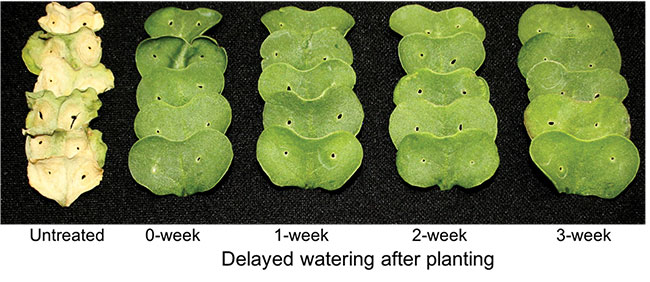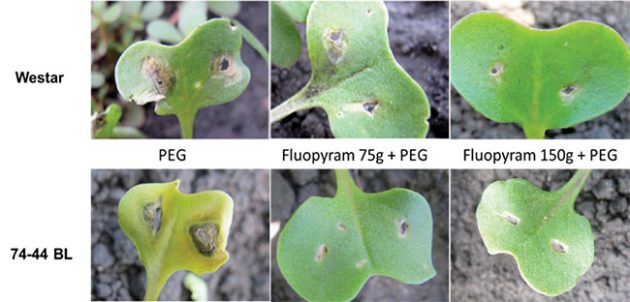
Features
Targeting early infection
Exploring seed treatment options to mitigate the impact of Blackleg on canola.
February 14, 2022 By Donna Fleury
 Effect of delayed watering (# weeks) on Fluopyram seed treatment (150g/100 kg) against cotyledon infection by Leptosphaeria maculans. Photo courtesy of Gary Peng.
Effect of delayed watering (# weeks) on Fluopyram seed treatment (150g/100 kg) against cotyledon infection by Leptosphaeria maculans. Photo courtesy of Gary Peng. Blackleg can be a serious disease for canola growers, impacting yields and profitability. In recent years, increasing disease levels in Western Canada have researchers and industry continuing to search for additional tools to improve Blackleg management. One strategy of interest is identifying and commercializing potential seed treatments that target aboveground Blackleg infection.
“In earlier studies, we conducted large trials across western Canada starting in 2011 when disease levels in southern Manitoba and other areas were increasing noticeably. In those trials, we compared foliar fungicide applications at both early timing and later timing at the crop bolting stage,” explains Gary Peng, research scientist with Agriculture and Agri-Food Canada (AAFC) in Saskatoon. “The results clearly showed that the early application for disease suppression was much more effective in reducing disease levels. We concluded that early infection is important to disease severity, but that fungicide application even early would not provide an economic yield benefit for Blackleg resistant varieties.”
Building on that study, Peng focused on identifying the critical stage of Blackleg infection in canola. He found that wounded cotyledons appeared to be the main pathway for stem infection, and depending on the year and variety resistance, the lower leaves up to the third leaf can also contribute to the infection. With foliar fungicides not showing economic benefits for widespread application, research into seed treatment options was the next step. Peng also looked to work by Australian colleagues showing that soil infection from roots would also contribute to the incidence and severity of Blackleg. He was interested in finding out if this holds true under the shorter growing season in western Canada, compared to Australia’s long growing season; and if there is a seed treatment that can block this avenue of infection.
“In 2013, we started working with Bayer, [the company formerly known as DuPont] and other companies to screen some of the new chemistries coming down the research and development pipeline, and did identify a couple of interesting chemistries, in particular fluopyram with Bayer,” Peng says. “We initiated a project with greenhouse trials to evaluate a range of fungicides for control of cotyledon infection by Leptosphaeria maculans and Blackleg disease of canola. Understanding that cotyledon and lower-leaf infection play a major role in Blackleg disease development, we wanted to determine if a seed treatment that targets early infection could be more cost-effective than a foliar fungicide application.”
The initial growth chamber assessments compared the Blackleg-susceptible (S) canola variety ‘Westar’ and resistant (R) variety ‘InVigor L157H’, and evaluated fluopyram, three new seed-treatment candidates and three undisclosed chemistries against the industry standard seed treatments of Prosper EverGol or Helix Vibrance for efficacy against Blackleg. A control was included, Fluquinconazole, a fungicide commonly used for canola in Australia against Blackleg. Additional objectives were to determine the impact of delayed soil moisture after planting on seed treatment efficacy, and to explore the potential of fluopyram treatment to induce canola defense
responses against diseases.
The results of the controlled experiments showed that fluopyram had greater efficacy than fluquinconazole in limiting cotyledon infection, while regular seed treatments with Prosper EverGold or Helix Vibrance were ineffective. The study also showed that the efficacy of fluopyram was unlikely be affected by a slight delay in germination due to a soil moisture deficit after seeding. Researchers were interested to note that fluopyram not only showed typical effects of conventional fungicides, it also indicated the potential for inducing plant defense response against the infection.
“We moved to field trials in 2017 and 2018 at Melfort and Brandon, using the same methods as in the controlled experiments,” Peng says. “Our field research using fluopyram showed that it was highly effective for reducing cotyledon infection on both susceptible and resistant canola cultivars on a range of field conditions, although the efficacy was slightly lower than under controlled-environment conditions where cotyledon infection was inhibited completely. Fluopryam also reduced Blackleg disease (in stems) on the susceptible Westar cultivar, while the efficacy was insignificant on resistant varieties as the disease index was very low (lesss than 10 per cent) on these varieties already.” Fluopyram seed treatment was registered in 2019 and Peng is continuing to work with BASF to conduct additional field trials to confirm the efficacy under more field conditions on the prairies.
“Once we have completed these field trials, we will have information on how important soil inoculum is to infection levels and if any of the seed treatments including current registered products, are effective against soil infection,” Peng adds. “The results will also show product efficacy on susceptible and resistant cultivars, which will provide very practical information for recommendations for growers going forward.”

Lesion size on Westar (susceptible) and 74-44 BL (resistant) treated with Prosper EverGol (PEG, control), PEG + fluopyram at 75g and 150g/100 kg, respectively, at 10 days post inoculation in field trials. Photo courtesy of Gary Peng.
Peng also has a new project underway to search for additional seed treatment applications that could provide extended protection beyond the cotyledon stage, even up to the three- or six-leaf stage. The trials include various aspects, such as effectiveness at different plant stages and the window of seedling protection, along with the potential impact on efficacy from soil conditions at seeding. The field conditions in 2021 were very dry, so all of the trial plots were inoculated with Blackleg pathogens. The various new fungicides were added to either Helix or Prosper base as a seed treatment package and for comparison.
“We have come across a couple of candidates with the potential to provide extended protection beyond the cotyledon stage and are working with companies on the development,” Peng adds. “We are also looking at the mechanism of extended protection beyond the fungicidal effect. Some of the candidates don’t have a direct fungicidal effect, but seem to have the ability to
develop induced resistance from the plant in response to infection. This is very interesting, and would provide a different mode of action and extended protection to canola seedlings. Field trials are also underway in 2021 to test some of the new candidates and to determine how promising they may be as seed treatments with extended protection against Blackleg.”
Peng is hoping to launch a new project in 2022 to evaluate several new chemistries for efficacy to control early infection by Blackleg and clubroot and for their modes of action. This will help expand the seed treatment options and generate the information to assist for recommendations for growers.
“Fluopyram seed treatment could be a new management tool because it targets the critical infection window at the cotyledon stage. Fluopyram may also be useful when variety resistance is being eroded due to a shift in the pathogen population, and during the restoration of variety resistance.”